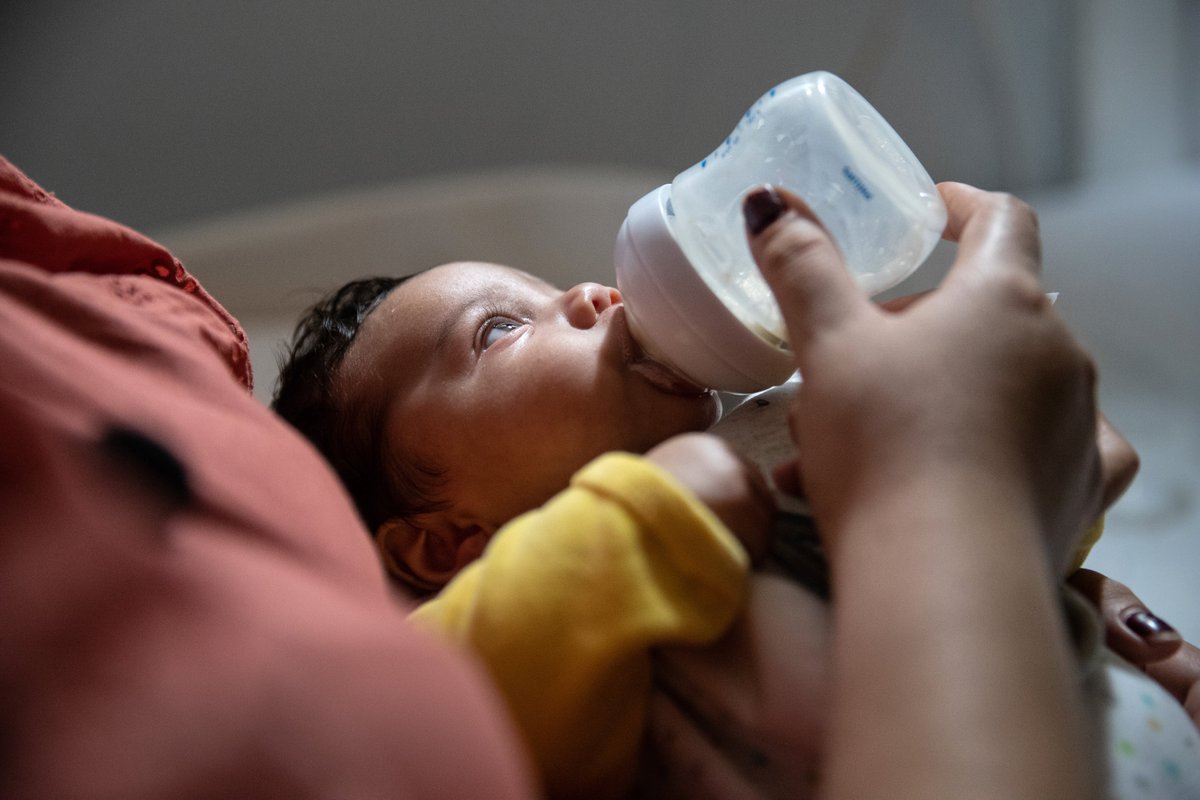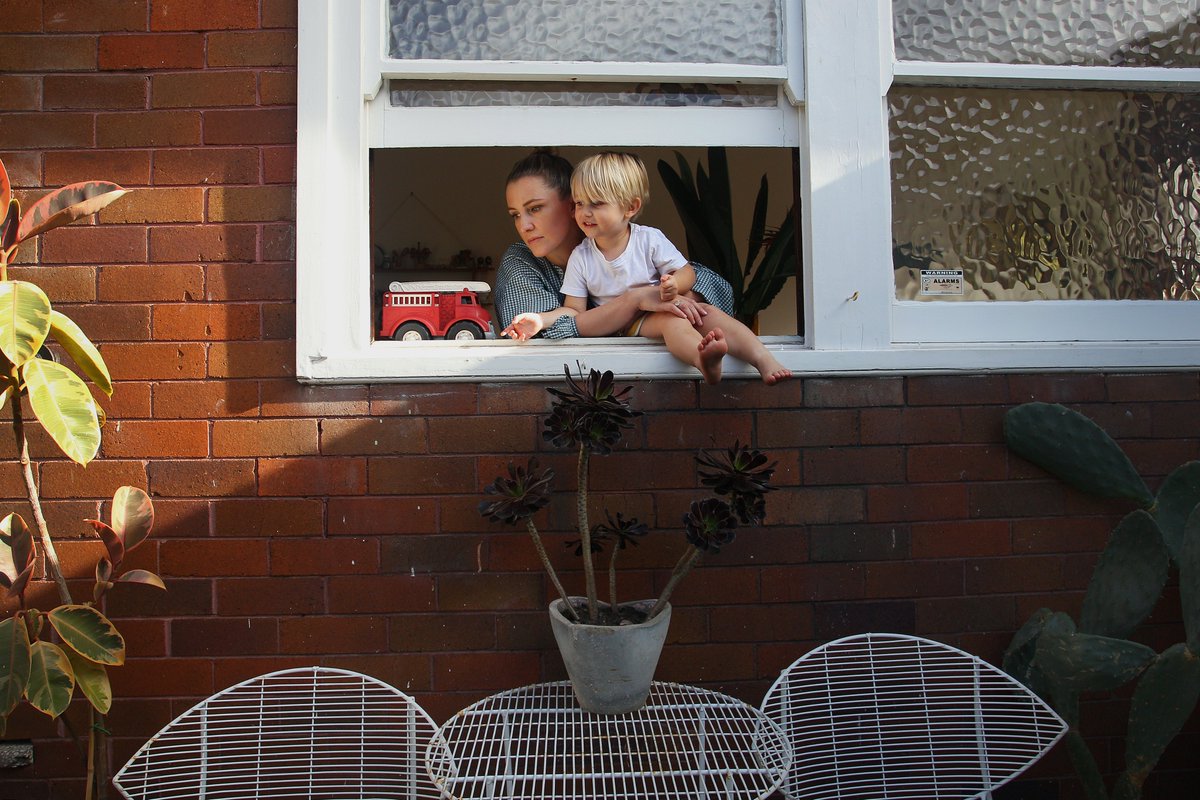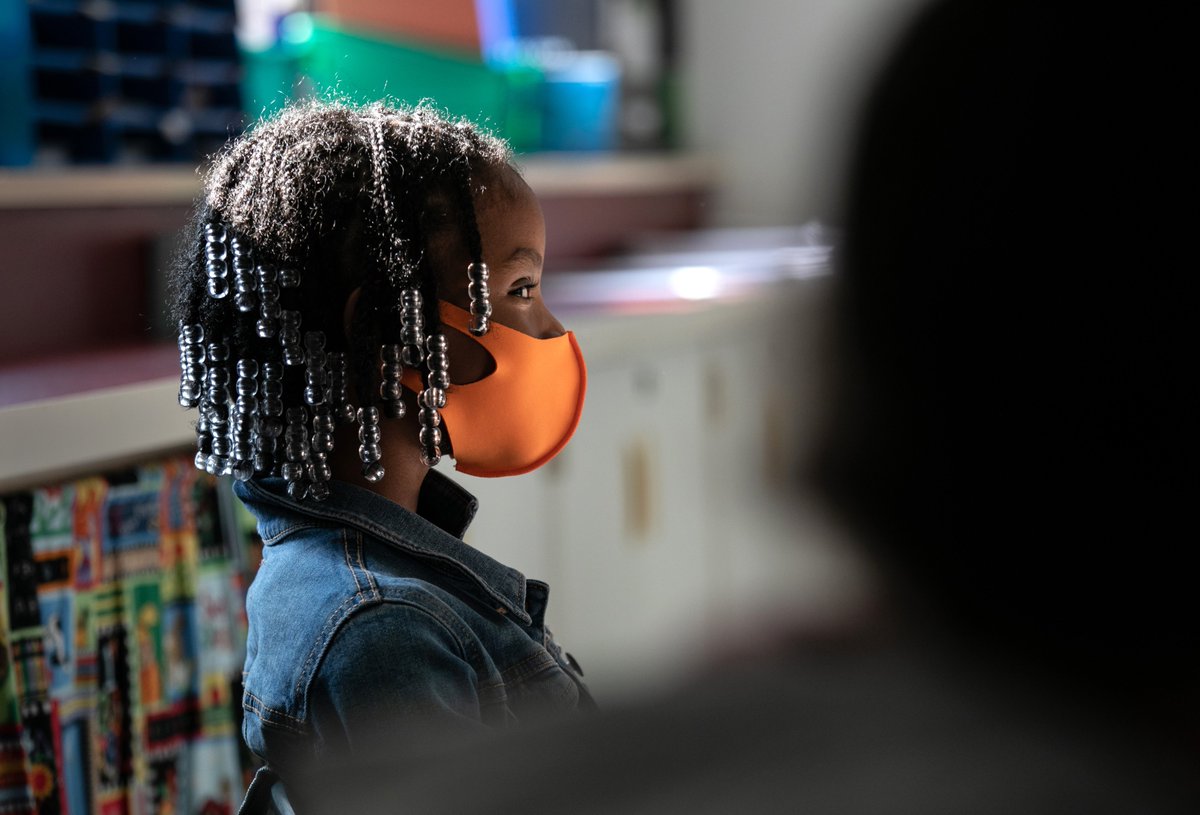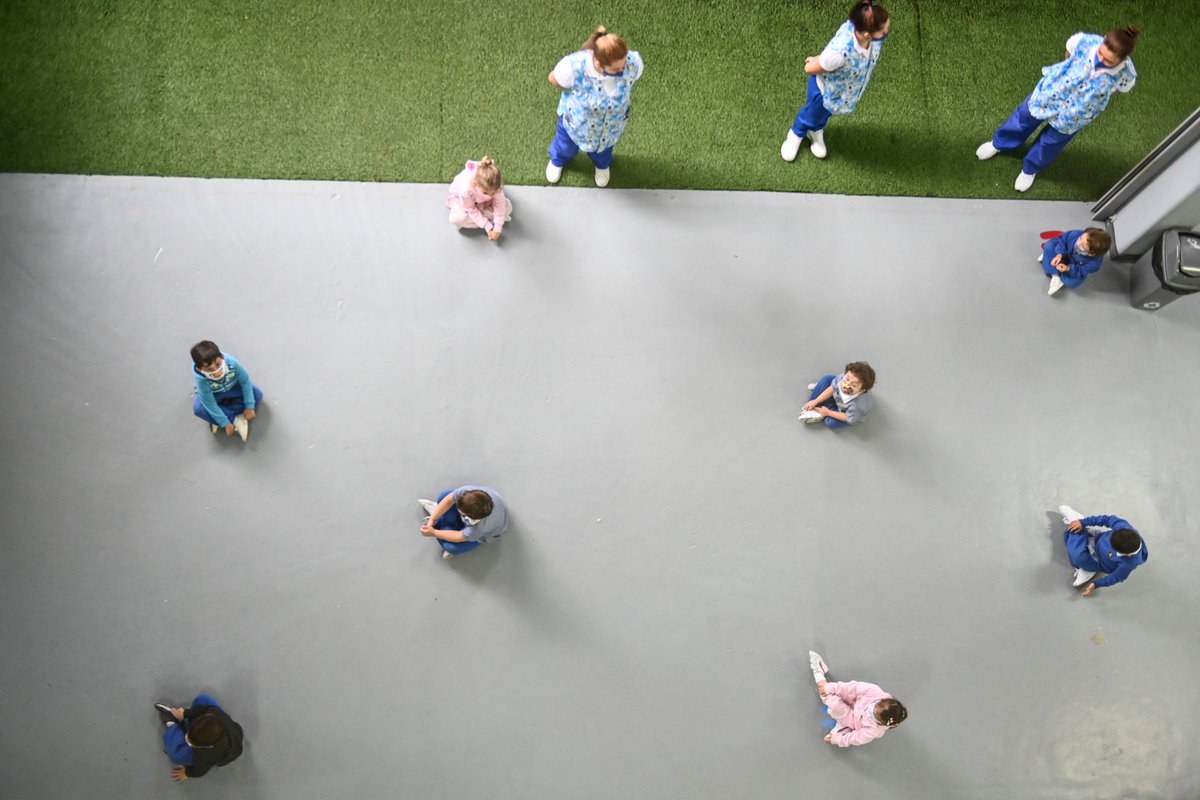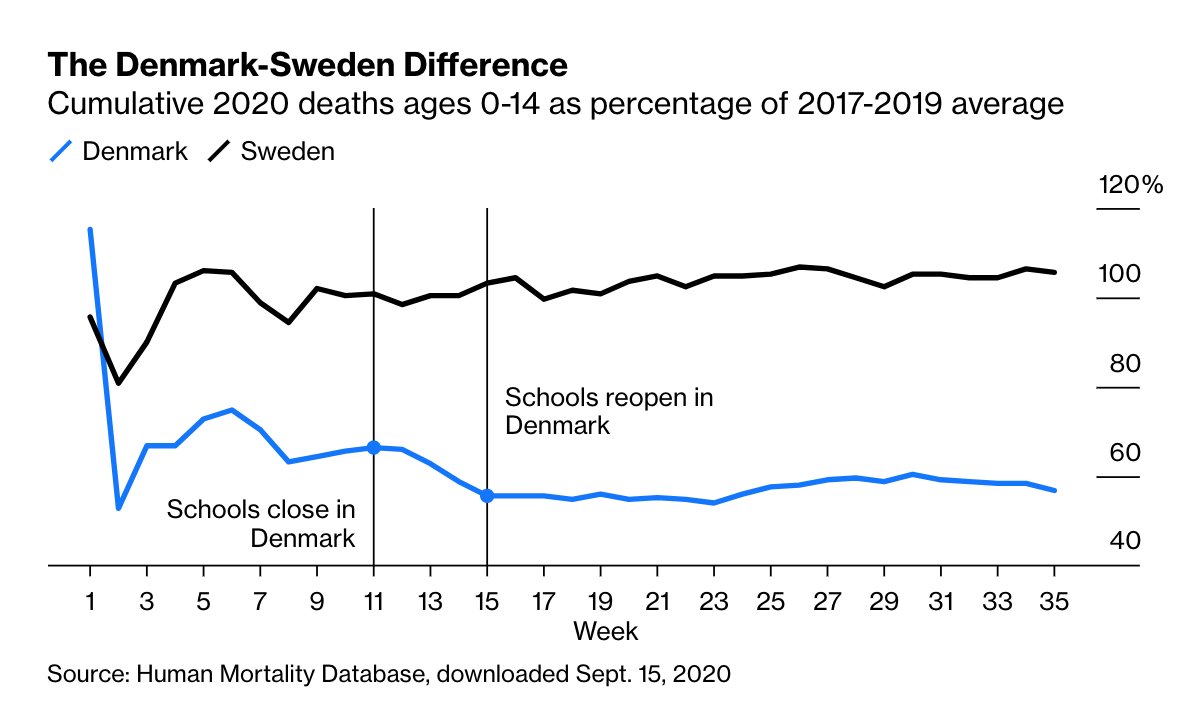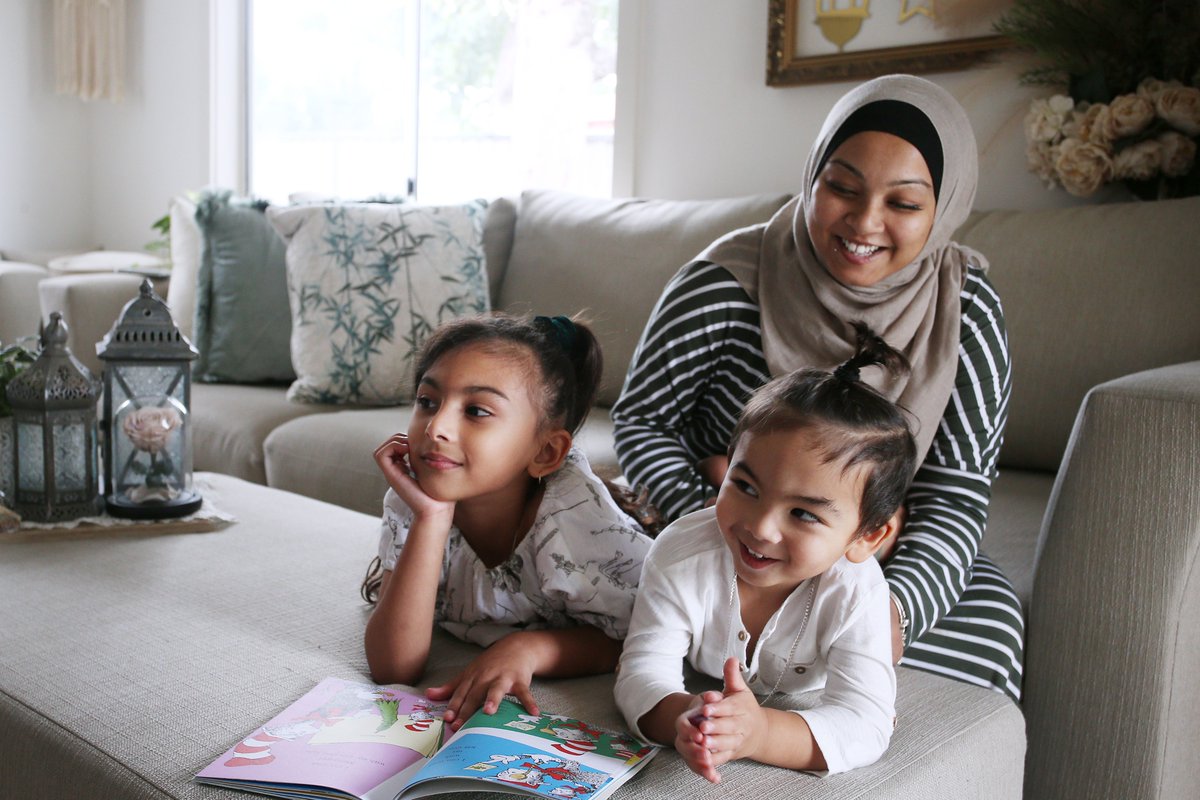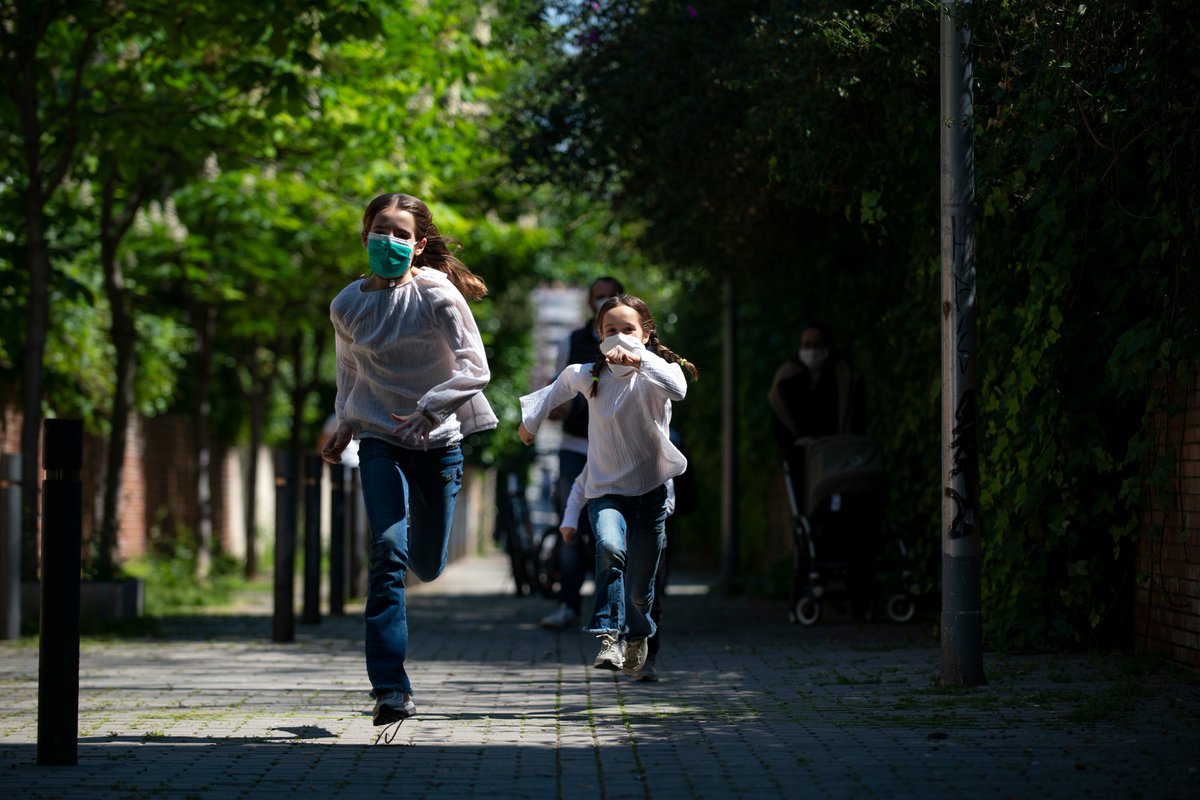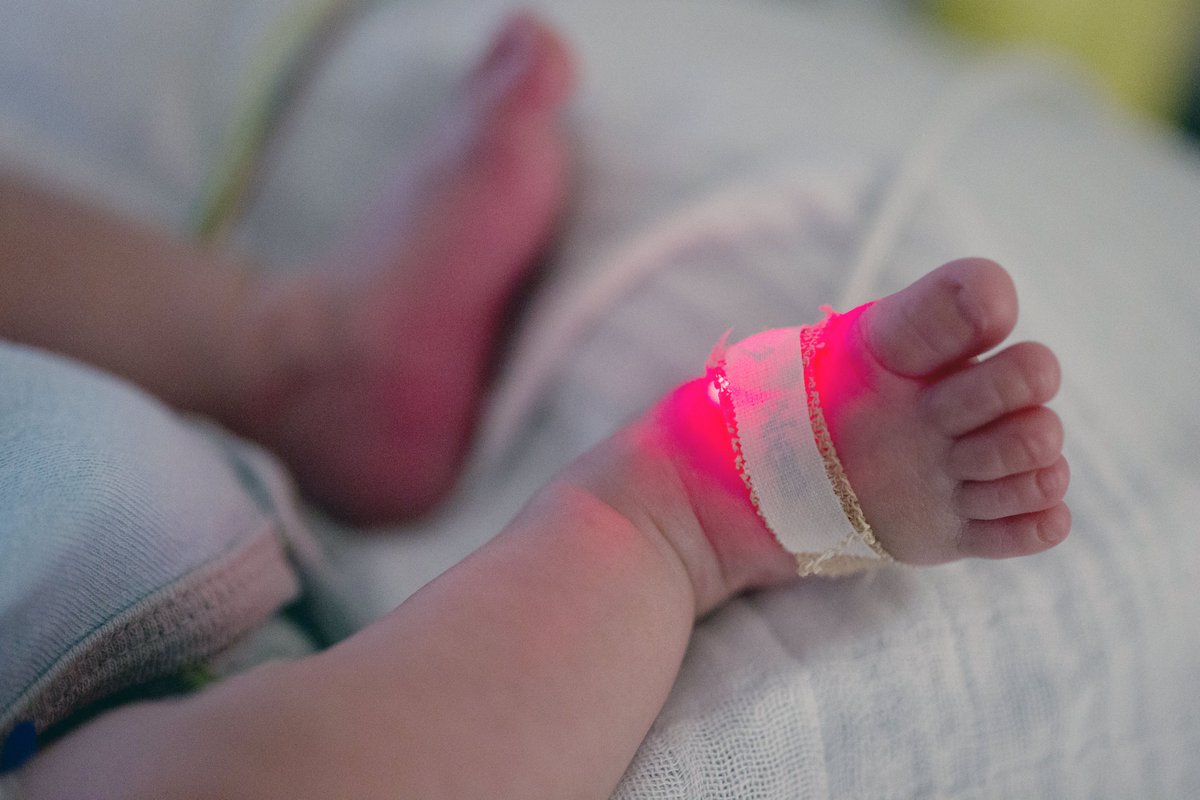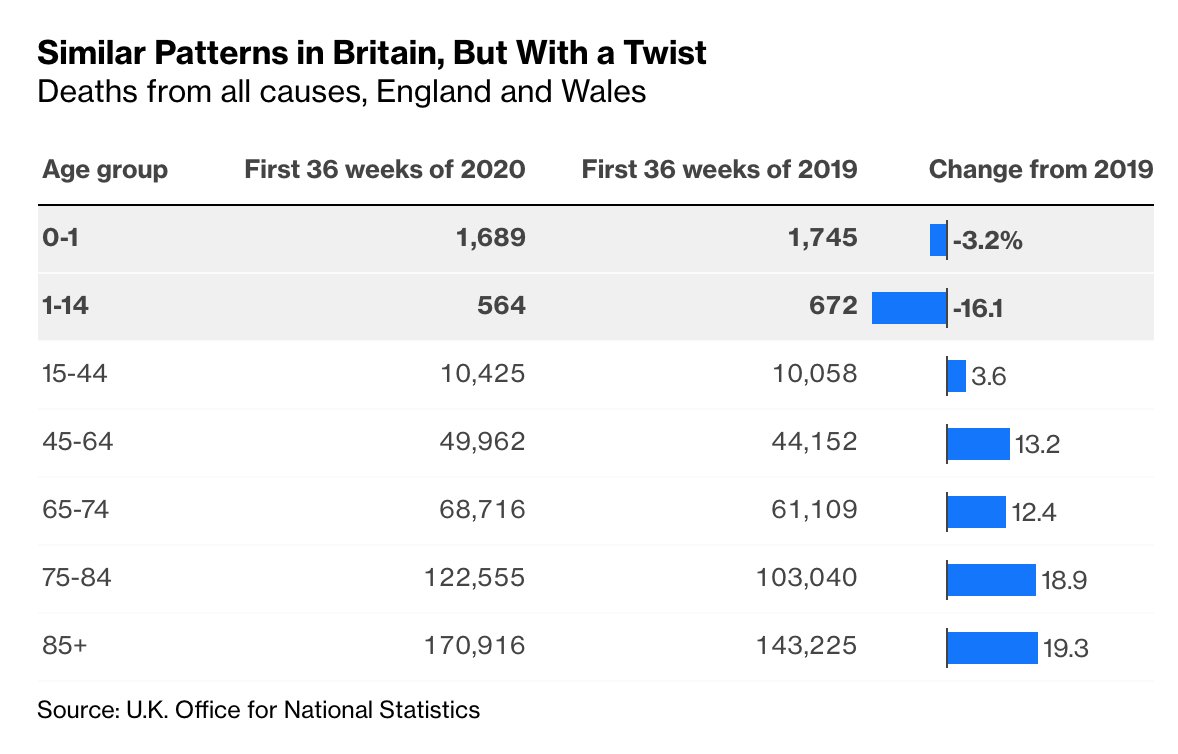A bit of good news for 2020: Fewer children have died in the U.S. than would be expected in a non-pandemic year https://trib.al/1OJQIHt ">https://trib.al/1OJQIHt&q...
Something similar has been happening in other affluent nations.
22 of the 29 countries with weekly data for 2020 in the Human Mortality Database have seen deaths in the 14-and-under age group decline this year. Here’s a selection https://abs.twimg.com/emoji/v2/... draggable="false" alt="⬇️" title="Pfeil nach unten" aria-label="Emoji: Pfeil nach unten"> http://trib.al/1OJQIHt ">https://trib.al/1OJQIHt&q...
https://abs.twimg.com/emoji/v2/... draggable="false" alt="⬇️" title="Pfeil nach unten" aria-label="Emoji: Pfeil nach unten"> http://trib.al/1OJQIHt ">https://trib.al/1OJQIHt&q...
22 of the 29 countries with weekly data for 2020 in the Human Mortality Database have seen deaths in the 14-and-under age group decline this year. Here’s a selection
What& #39;s causing the decline in childhood deaths?
“The overall picture that is emerging is that stay-at-home orders have provided stresses but also some protection,” sociologist Michel Guillot told @foxjust http://trib.al/1OJQIHt ">https://trib.al/1OJQIHt&q...
“The overall picture that is emerging is that stay-at-home orders have provided stresses but also some protection,” sociologist Michel Guillot told @foxjust http://trib.al/1OJQIHt ">https://trib.al/1OJQIHt&q...
For young children, the added protection may have been due to:
 https://abs.twimg.com/emoji/v2/... draggable="false" alt="🦠" title="Microbe" aria-label="Emoji: Microbe">Less exposure to viruses
https://abs.twimg.com/emoji/v2/... draggable="false" alt="🦠" title="Microbe" aria-label="Emoji: Microbe">Less exposure to viruses
 https://abs.twimg.com/emoji/v2/... draggable="false" alt="🚑" title="Rettungswagen" aria-label="Emoji: Rettungswagen">Fewer accidents
https://abs.twimg.com/emoji/v2/... draggable="false" alt="🚑" title="Rettungswagen" aria-label="Emoji: Rettungswagen">Fewer accidents
 https://abs.twimg.com/emoji/v2/... draggable="false" alt="🍼" title="Babyflasche" aria-label="Emoji: Babyflasche">More attentive child care
https://abs.twimg.com/emoji/v2/... draggable="false" alt="🍼" title="Babyflasche" aria-label="Emoji: Babyflasche">More attentive child care
 https://abs.twimg.com/emoji/v2/... draggable="false" alt="🤱🏻" title="Stillen (heller Hautton)" aria-label="Emoji: Stillen (heller Hautton)">Breastfeeding
https://abs.twimg.com/emoji/v2/... draggable="false" alt="🤱🏻" title="Stillen (heller Hautton)" aria-label="Emoji: Stillen (heller Hautton)">Breastfeeding
 https://abs.twimg.com/emoji/v2/... draggable="false" alt="🤰🏿" title="Schwangere Frau (dunkler Hautton)" aria-label="Emoji: Schwangere Frau (dunkler Hautton)">Expectant mothers at home
https://abs.twimg.com/emoji/v2/... draggable="false" alt="🤰🏿" title="Schwangere Frau (dunkler Hautton)" aria-label="Emoji: Schwangere Frau (dunkler Hautton)">Expectant mothers at home
http://trib.al/1OJQIHt ">https://trib.al/1OJQIHt&q...
http://trib.al/1OJQIHt ">https://trib.al/1OJQIHt&q...
For infants in the U.S. the top cause of death every year is “certain conditions originating in the perinatal period.”
Reports of a sharp drop in premature births in the early months of the pandemic should reduce those deaths http://trib.al/1OJQIHt ">https://trib.al/1OJQIHt&q...
Reports of a sharp drop in premature births in the early months of the pandemic should reduce those deaths http://trib.al/1OJQIHt ">https://trib.al/1OJQIHt&q...
For kids ages 1–14 the top cause of death in the U.S. is accidents.
Being stuck at home with parents likely reduces the chances of those. France reported a drop in under-25 deaths in France in March/April, which was “probably due to containment measures” http://trib.al/1OJQIHt ">https://trib.al/1OJQIHt&q...
Being stuck at home with parents likely reduces the chances of those. France reported a drop in under-25 deaths in France in March/April, which was “probably due to containment measures” http://trib.al/1OJQIHt ">https://trib.al/1OJQIHt&q...
Economist @lymanstoneky, one of the first people to point out the children’s mortality decline in the U.S., cites school closures as the crucial containment measure.
“Going to school may expose kids to mortality risk on the way,” he told @foxjust http://trib.al/1OJQIHt ">https://trib.al/1OJQIHt&q...
“Going to school may expose kids to mortality risk on the way,” he told @foxjust http://trib.al/1OJQIHt ">https://trib.al/1OJQIHt&q...
Also, kids get sick at school.
99.9% of the time they’re fine. Sometimes they aren’t. It turns out, school-age deaths of infectious disease are much more seasonal than adult deaths of infectious disease http://trib.al/1OJQIHt ">https://trib.al/1OJQIHt&q...
99.9% of the time they’re fine. Sometimes they aren’t. It turns out, school-age deaths of infectious disease are much more seasonal than adult deaths of infectious disease http://trib.al/1OJQIHt ">https://trib.al/1OJQIHt&q...
By taking kids out of school in the spring, it may have kept a few from getting fatally ill from diseases other than Covid.
When comparing Denmark, which closed schools in March, and neighboring Sweden, where schools never closed, the difference is clear http://trib.al/1OJQIHt ">https://trib.al/1OJQIHt&q...
When comparing Denmark, which closed schools in March, and neighboring Sweden, where schools never closed, the difference is clear http://trib.al/1OJQIHt ">https://trib.al/1OJQIHt&q...
This may be in part a continuation of existing trends.
In the U.S., for example, the mortality rate for children ages 1 through 14 declined almost 30% from 1999 through 2018, mainly because the number of accidental deaths went down http://trib.al/1OJQIHt ">https://trib.al/1OJQIHt&q...
In the U.S., for example, the mortality rate for children ages 1 through 14 declined almost 30% from 1999 through 2018, mainly because the number of accidental deaths went down http://trib.al/1OJQIHt ">https://trib.al/1OJQIHt&q...
One possible takeaway is that the rise in so-called helicopter parenting is saving some youngsters’ lives.
Covid-19 school shutdowns and work-from-arrangements would seem to have brought the helicoptering to a new level of intensity http://trib.al/1OJQIHt ">https://trib.al/1OJQIHt&q...
Covid-19 school shutdowns and work-from-arrangements would seem to have brought the helicoptering to a new level of intensity http://trib.al/1OJQIHt ">https://trib.al/1OJQIHt&q...
Happily, not many children ages 1 through 14 in the U.S. die in any case.
Further declines in these mortality rates would be great, but surely not great enough to merit keeping schools closed and parents stuck at home with their kids indefinitely http://trib.al/1OJQIHt ">https://trib.al/1OJQIHt&q...
Further declines in these mortality rates would be great, but surely not great enough to merit keeping schools closed and parents stuck at home with their kids indefinitely http://trib.al/1OJQIHt ">https://trib.al/1OJQIHt&q...
Infants, in contrast, have a high mortality rate than any other age group under 55.
If something can be learned from the pandemic that would reduce infant deaths in the U.S. significantly, that could be a really big deal http://trib.al/1OJQIHt ">https://trib.al/1OJQIHt&q...
If something can be learned from the pandemic that would reduce infant deaths in the U.S. significantly, that could be a really big deal http://trib.al/1OJQIHt ">https://trib.al/1OJQIHt&q...
In the U.K., mothers get 39 weeks of paid maternity leave.
That’s quite different from how things work in the U.S., which may help explain why the England and Wales infant mortality rate was about two-thirds that of the U.S. in 2018 http://trib.al/1OJQIHt ">https://trib.al/1OJQIHt&q...
That’s quite different from how things work in the U.S., which may help explain why the England and Wales infant mortality rate was about two-thirds that of the U.S. in 2018 http://trib.al/1OJQIHt ">https://trib.al/1OJQIHt&q...
Lower child mortality is something to applaud, but there’s one caveat:
Covid-19 is the disease has mostly spared children’s lives, but the pandemic-induced disruptions to health care, nutrition and mental health could prove to be dire for them http://trib.al/1OJQIHt ">https://trib.al/1OJQIHt&q...
Covid-19 is the disease has mostly spared children’s lives, but the pandemic-induced disruptions to health care, nutrition and mental health could prove to be dire for them http://trib.al/1OJQIHt ">https://trib.al/1OJQIHt&q...

 Read on Twitter
Read on Twitter
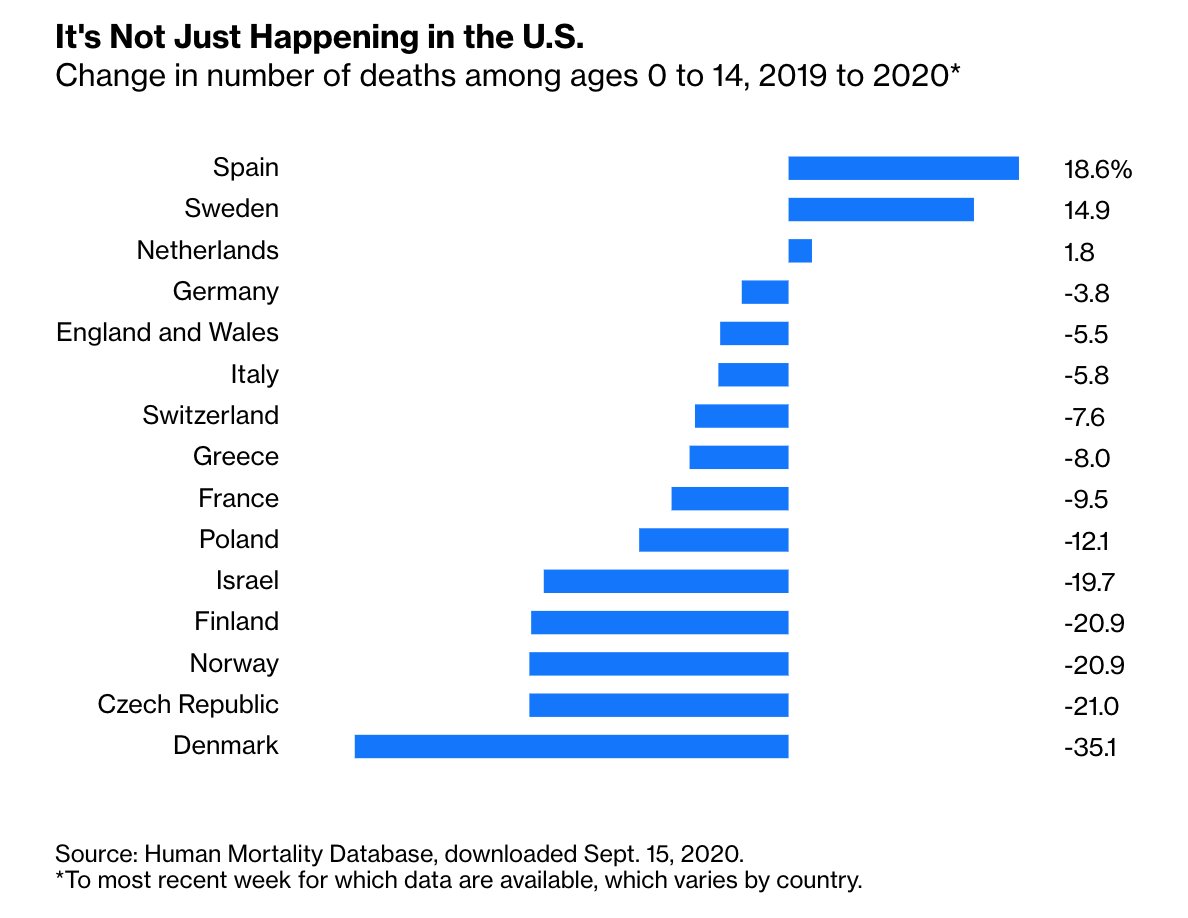 https://trib.al/1OJQIHt&q..." title="Something similar has been happening in other affluent nations.22 of the 29 countries with weekly data for 2020 in the Human Mortality Database have seen deaths in the 14-and-under age group decline this year. Here’s a selectionhttps://abs.twimg.com/emoji/v2/... draggable="false" alt="⬇️" title="Pfeil nach unten" aria-label="Emoji: Pfeil nach unten"> https://trib.al/1OJQIHt&q..." class="img-responsive" style="max-width:100%;"/>
https://trib.al/1OJQIHt&q..." title="Something similar has been happening in other affluent nations.22 of the 29 countries with weekly data for 2020 in the Human Mortality Database have seen deaths in the 14-and-under age group decline this year. Here’s a selectionhttps://abs.twimg.com/emoji/v2/... draggable="false" alt="⬇️" title="Pfeil nach unten" aria-label="Emoji: Pfeil nach unten"> https://trib.al/1OJQIHt&q..." class="img-responsive" style="max-width:100%;"/>
 Less exposure to viruseshttps://abs.twimg.com/emoji/v2/... draggable="false" alt="🚑" title="Rettungswagen" aria-label="Emoji: Rettungswagen">Fewer accidentshttps://abs.twimg.com/emoji/v2/... draggable="false" alt="🍼" title="Babyflasche" aria-label="Emoji: Babyflasche">More attentive child carehttps://abs.twimg.com/emoji/v2/... draggable="false" alt="🤱🏻" title="Stillen (heller Hautton)" aria-label="Emoji: Stillen (heller Hautton)">Breastfeedinghttps://abs.twimg.com/emoji/v2/... draggable="false" alt="🤰🏿" title="Schwangere Frau (dunkler Hautton)" aria-label="Emoji: Schwangere Frau (dunkler Hautton)">Expectant mothers at home https://trib.al/1OJQIHt&q..." title="For young children, the added protection may have been due to:https://abs.twimg.com/emoji/v2/... draggable="false" alt="🦠" title="Microbe" aria-label="Emoji: Microbe">Less exposure to viruseshttps://abs.twimg.com/emoji/v2/... draggable="false" alt="🚑" title="Rettungswagen" aria-label="Emoji: Rettungswagen">Fewer accidentshttps://abs.twimg.com/emoji/v2/... draggable="false" alt="🍼" title="Babyflasche" aria-label="Emoji: Babyflasche">More attentive child carehttps://abs.twimg.com/emoji/v2/... draggable="false" alt="🤱🏻" title="Stillen (heller Hautton)" aria-label="Emoji: Stillen (heller Hautton)">Breastfeedinghttps://abs.twimg.com/emoji/v2/... draggable="false" alt="🤰🏿" title="Schwangere Frau (dunkler Hautton)" aria-label="Emoji: Schwangere Frau (dunkler Hautton)">Expectant mothers at home https://trib.al/1OJQIHt&q..." class="img-responsive" style="max-width:100%;"/>
Less exposure to viruseshttps://abs.twimg.com/emoji/v2/... draggable="false" alt="🚑" title="Rettungswagen" aria-label="Emoji: Rettungswagen">Fewer accidentshttps://abs.twimg.com/emoji/v2/... draggable="false" alt="🍼" title="Babyflasche" aria-label="Emoji: Babyflasche">More attentive child carehttps://abs.twimg.com/emoji/v2/... draggable="false" alt="🤱🏻" title="Stillen (heller Hautton)" aria-label="Emoji: Stillen (heller Hautton)">Breastfeedinghttps://abs.twimg.com/emoji/v2/... draggable="false" alt="🤰🏿" title="Schwangere Frau (dunkler Hautton)" aria-label="Emoji: Schwangere Frau (dunkler Hautton)">Expectant mothers at home https://trib.al/1OJQIHt&q..." title="For young children, the added protection may have been due to:https://abs.twimg.com/emoji/v2/... draggable="false" alt="🦠" title="Microbe" aria-label="Emoji: Microbe">Less exposure to viruseshttps://abs.twimg.com/emoji/v2/... draggable="false" alt="🚑" title="Rettungswagen" aria-label="Emoji: Rettungswagen">Fewer accidentshttps://abs.twimg.com/emoji/v2/... draggable="false" alt="🍼" title="Babyflasche" aria-label="Emoji: Babyflasche">More attentive child carehttps://abs.twimg.com/emoji/v2/... draggable="false" alt="🤱🏻" title="Stillen (heller Hautton)" aria-label="Emoji: Stillen (heller Hautton)">Breastfeedinghttps://abs.twimg.com/emoji/v2/... draggable="false" alt="🤰🏿" title="Schwangere Frau (dunkler Hautton)" aria-label="Emoji: Schwangere Frau (dunkler Hautton)">Expectant mothers at home https://trib.al/1OJQIHt&q..." class="img-responsive" style="max-width:100%;"/>
